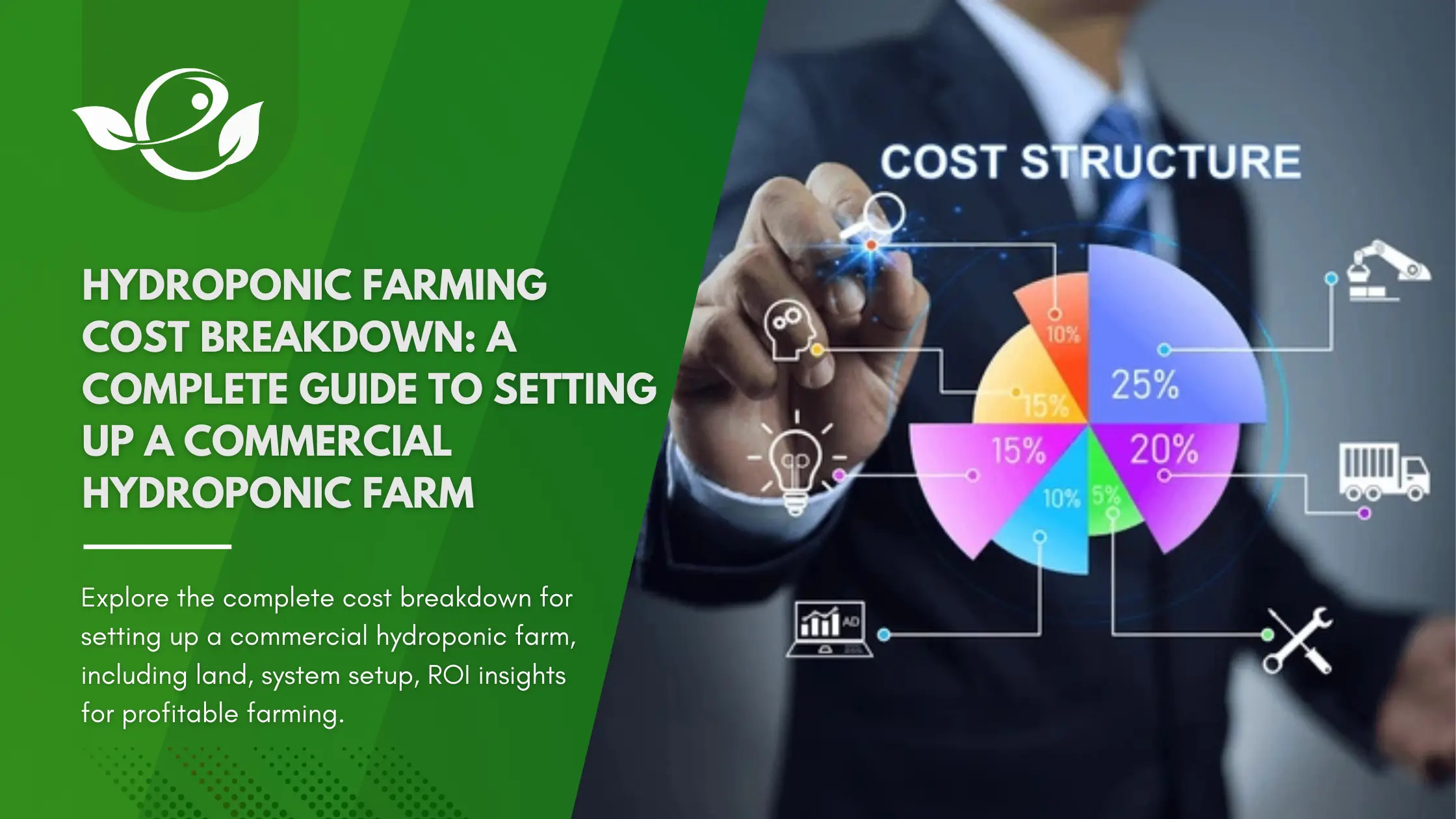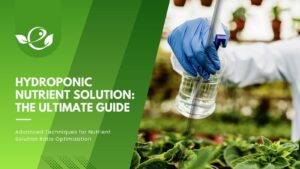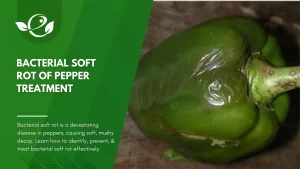Table of Contents
In recent years, hydroponics has emerged as a sustainable and efficient agricultural practice, offering farmers higher yields, reduced water usage, and the ability to grow crops in areas with poor soil conditions. Commercial hydroponic setups are increasingly becoming a popular option for large-scale farming. This guide aims to break down the cost factors involved in setting up an outdoor hydroponic farm, giving you a clear picture of what investments are required and how to budget accordingly.
Land Requirements and Preparation
Land Size and Location
The first consideration for an outdoor hydroponic farm is land. The required land size depends on the scale of your operation, with commercial farms typically starting from 1 acre and scaling up to tens of acres for large operations.
- Ideal Land Size: For a small-scale commercial farm, 1–5 acres is common. Larger operations may extend to 10 acres or more.
- Cost of Land: Land prices can vary widely depending on location. For instance, rural areas in India may offer land at significantly lower rates than peri-urban areas.
Example costs:- Rural land: ₹15 lakh per acre
- Peri-urban land: ₹60 lakh per acre
Land Preparation Costs
Even though hydroponics doesn’t require soil, preparing the land is essential for efficient drainage and system installation. Typical land preparation tasks include:
- Site Leveling: Ensuring the land is flat enough for water flow and system efficiency.
- Fencing: Securing the site from external threats like animals or unauthorized access.
- Basic infrastructure: Storage areas, water pumps, and staff residence needs to be built.
Estimated costs for land preparation: ₹ 20-30 lakhs
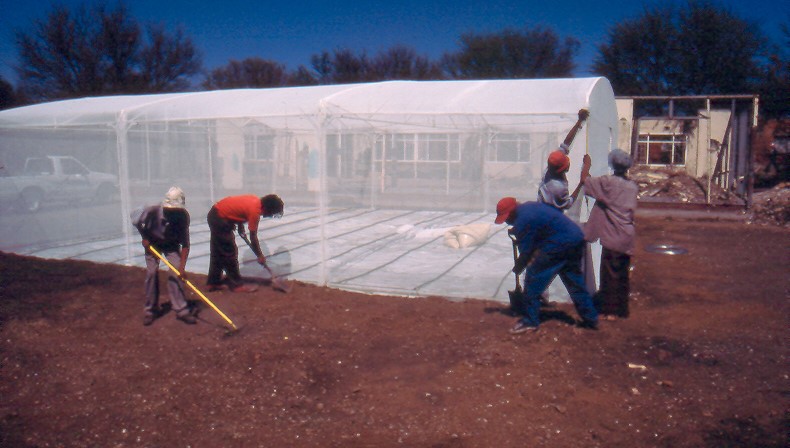
Greenhouse or Polyhouse Structures
When setting up a commercial outdoor hydroponic farm, choosing the right protective structure is critical. The structure should shield crops from environmental stressors such as excessive sunlight, wind, and rain while promoting a stable microclimate for optimal growth. The three most commonly used structures for commercial hydroponic farming in India are Naturally Ventilated Polyhouses, Fan Pad Polyhouses, and Cravo’s Retractable Roof Greenhouses. Each option has its pros and cons based on cost, climate control, and operational complexity.
1. Naturally Ventilated Polyhouse
A Naturally Ventilated Polyhouse is one of the most widely adopted structures in India for outdoor hydroponic farming. This structure is designed with natural ventilation, meaning that the air exchange happens passively through vents located on the sides and roof of the polyhouse, without the need for additional mechanical systems like fans or misters.
Pros:
- Cost-Effective: Naturally ventilated polyhouses are relatively inexpensive compared to more advanced systems like fan pad polyhouses or Cravo greenhouses. The setup cost per square meter is significantly lower.
- Low Energy Consumption: Since it relies on passive ventilation, there is no need for electricity to power fans or cooling systems, reducing operational costs.
- Simple to Maintain: The absence of mechanical components like fans, pumps, and motors makes this structure easier to maintain and less prone to technical failures.
Cons:
- Limited Climate Control: Natural ventilation depends on external environmental conditions, making it difficult to control temperature and humidity with precision. This can be problematic in regions with extreme climates (e.g., very hot or very cold).
- Pest and Disease Risk: The open ventilation system allows for the ingress of pests and diseases, which could impact the crops if not managed effectively.
- Not Suitable for All Crops: Some crops that require specific environmental conditions (e.g., high humidity or cooler temperatures) may not thrive in this system.
Estimated Cost: ₹900-₹1100 per square meter.
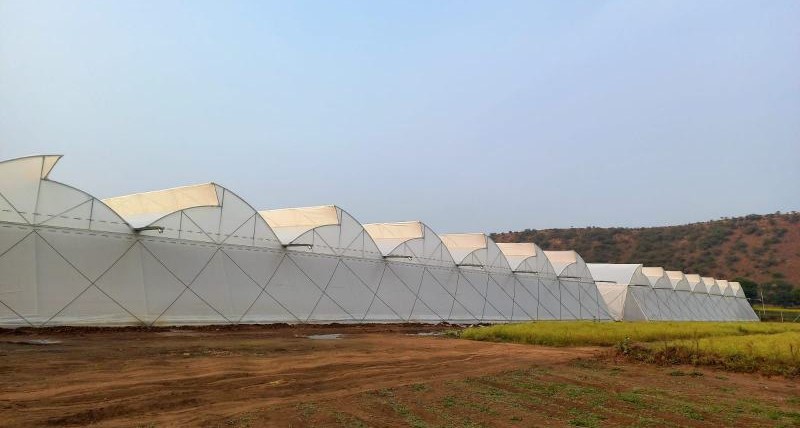
2. Fan Pad Polyhouse
A Fan Pad Polyhouse is a climate-controlled structure that uses an evaporative cooling system to regulate temperature. This system relies on fans and wet pads installed at opposite ends of the polyhouse. As air passes through the wet pads, it cools down and is circulated by fans, creating a controlled environment ideal for hydroponic crops that require consistent temperatures.
Pros:
- Excellent Climate Control: This system allows for precise temperature and humidity regulation, making it ideal for growing crops that are sensitive to climatic changes. The controlled environment can lead to higher yields and better crop quality.
- Extended Growing Season: With a fan pad system, crops can be grown year-round, regardless of external weather conditions. This can significantly boost production cycles, especially in regions with extreme climates.
- Pest Control: The sealed nature of a fan pad polyhouse reduces the risk of pest invasion, providing a more secure environment for the plants.
Cons:
- High Initial and Operational Costs: The installation of fans, wet pads, and the necessary plumbing systems increases both the initial setup cost and ongoing energy consumption.
- Maintenance-Intensive: The mechanical components such as fans, motors, and water pumps require regular maintenance. The pads also need to be cleaned or replaced periodically to ensure optimal performance.
- Energy-Dependent: The system’s reliance on fans and water circulation pumps means that it consumes a significant amount of energy, making it less viable in areas with unreliable power supply unless backed by solar or alternative energy sources.
Estimated Cost: ₹1400-₹1700 per square meter.
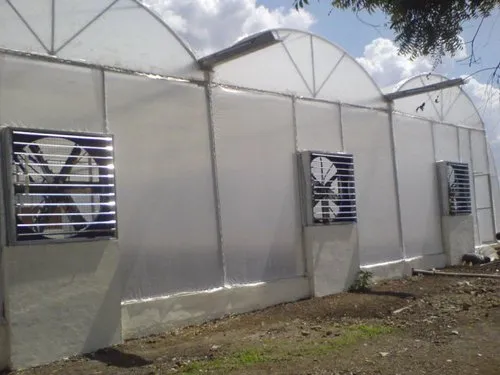
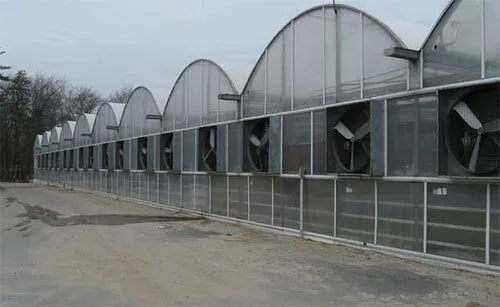
3. Cravo’s Retractable Roof Greenhouse
Cravo’s Retractable Roof Greenhouse is a state-of-the-art system that combines the benefits of both indoor and outdoor environments. The retractable roof can open and close depending on weather conditions, giving farmers the flexibility to expose crops to natural sunlight and fresh air when beneficial, or to protect them from extreme weather like rain, hail, or intense heat.
Pros:
- Flexible Microclimate Control: The retractable roof allows for unparalleled control over the growing environment. You can expose crops to outdoor conditions when the weather is favorable and protect them when it’s not. This can reduce energy consumption by taking advantage of natural sunlight and ventilation.
- High Yield Potential: The ability to control both the indoor and outdoor environment helps optimize growing conditions, leading to higher yields and improved crop quality.
- Pest and Disease Management: Since the greenhouse can be fully sealed, the risk of pest and disease infestation is minimized, similar to the fan pad polyhouse.
- Energy Savings: In favorable weather, the roof can be opened to eliminate the need for mechanical cooling or ventilation, reducing electricity consumption.
Cons:
- Very High Initial Costs: Cravo greenhouses are expensive to install due to the complexity of the retractable roof system. This makes it less accessible for small or medium-scale farmers unless heavily subsidized.
- Complex Maintenance: The retractable roof system, with its motorized components, requires regular maintenance and can be costly to repair if any mechanical parts fail.
- Skilled Labor Needed: Managing this type of structure requires a workforce trained in operating the retractable system and troubleshooting mechanical issues.
Estimated Cost: ₹2100 per square meter.
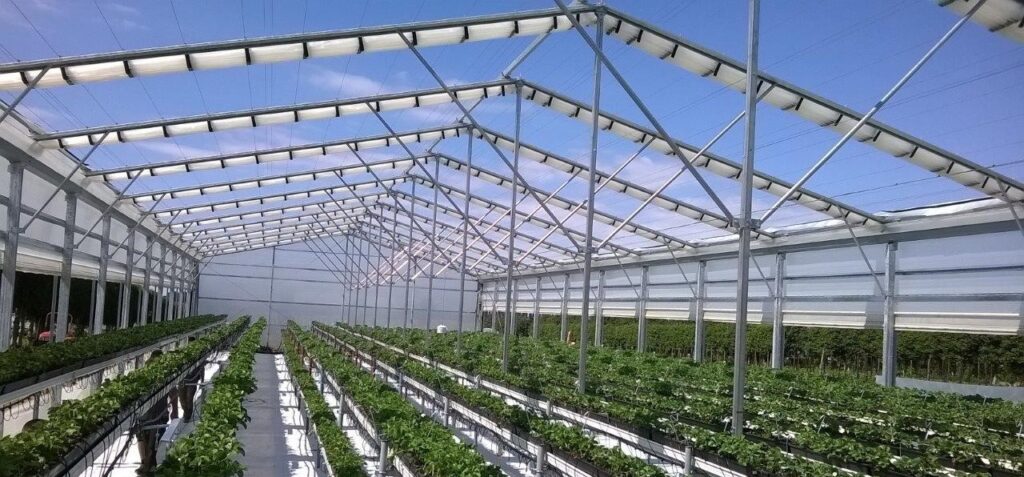
Summary of Greenhouse Options
Each type of greenhouse structure comes with its own set of advantages and drawbacks, and the choice depends on factors such as climate, budget, and the crops being grown.
- Naturally Ventilated Polyhouses are a cost-effective option with low operational expenses but limited climate control.
- Fan Pad Polyhouses offer superior environmental control at the expense of higher energy use and maintenance requirements.
- Cravo’s Retractable Roof Greenhouses provide maximum flexibility and yield potential but come with significant upfront costs and a need for skilled management.
By carefully considering these factors, you can choose the most suitable structure for your commercial hydroponic farm.
Hydroponic System Selection and Setup
Choosing the right hydroponic system for your outdoor hydroponic farm is crucial for optimizing both cost and crop yields. Here are three popular systems: Nutrient Film Technique (NFT), Dutch Bucket, and Grow Bags—each suited for different crops and scales.
1. Nutrient Film Technique (NFT)
NFT is ideal for growing small, fast-growing crops like leafy greens. A thin layer of nutrient solution flows over the plant roots in sloping channels, providing efficient water and nutrient delivery.
Pros:
- Water-efficient: Minimal water wastage due to recirculation.
- Scalable: Easily expanded by adding more channels.
Cons:
- Power-dependent: Requires continuous nutrient flow, needing reliable power.
- Limited to small crops: Not suitable for large plants with heavy root systems.
Estimated cost: ₹90 lakh – ₹1.2 crore per acre
2. Dutch Bucket System
The Dutch Bucket System is perfect for large, heavy-yield crops like tomatoes and cucumbers. Each plant is grown in a bucket filled with a growing medium, with a drip system providing nutrients.
Pros:
- Great for large crops: Handles extensive root systems and heavier plants.
- Modular: Easy to expand by adding more buckets.
Cons:
- Higher setup costs: Buckets and irrigation systems can be expensive.
- Space requirement: Takes more space per plant compared to NFT.
Estimated cost: ₹1.2 – ₹1.4 crore per acre.
3. Grow Bags
Grow Bags are an affordable option for various crops, from vine crops to leafy greens. Nutrients are delivered via drip irrigation to the growing medium inside the bags.
Pros:
- Low-cost: Inexpensive setup.
- Flexible: Easy to rearrange or move bags as needed.
Cons:
- Lifespan: Grow bags may need frequent replacement.
- Water management: Risk of drying out in hot climates if not irrigated properly.
Estimated cost: ₹60 lakh- 80 lakh per acre.
Conclusion
Each system has its benefits:
- NFT is efficient and scalable for small crops.
- Dutch Buckets are ideal for heavy-yielding plants.
- Grow Bags offer a flexible, low-cost option for various crops.
Choosing the right system depends on your crop selection, farm size, and budget.
RO and Water Management Costs for Hydroponic Farms
Water quality is critical in hydroponic farming because plants rely entirely on nutrient-rich water for their growth. Any contaminants or imbalances can severely affect crop health and yield. This makes Reverse Osmosis (RO) systems and water management essential components of a hydroponic farm setup. In this section, we’ll explore the costs and considerations associated with RO systems and broader water management strategies.
Importance of Water Quality in Hydroponics
In hydroponic systems, water serves as the primary medium for delivering nutrients to plants. The water’s pH, electrical conductivity (EC), and dissolved solids (TDS) must be carefully controlled to ensure optimal nutrient absorption by the plants.
Key Water Quality Factors:
- pH Levels: Ideal pH for hydroponic systems is typically between 5.5 and 6.5. Water with improper pH can hinder nutrient uptake.
- TDS and EC: Total Dissolved Solids (TDS) and Electrical Conductivity (EC) must be regulated to ensure that nutrient concentrations are correct for the specific crops.
- Hardness and Contaminants: Hard water with high mineral content (calcium, magnesium, etc.) can clog systems and alter nutrient balances. Other contaminants like chlorine, fluoride, or heavy metals can also harm plants.
Why RO Systems?
RO systems are commonly used in hydroponic farms to ensure water purity. RO removes up to 99% of contaminants, including dissolved salts, heavy metals, and harmful chemicals. This helps create an ideal base for nutrient solutions, giving farmers more precise control over crop nutrition.
RO System Components and Costs
A commercial RO system for hydroponics typically includes several components designed to filter, purify, and prepare water for use in the farm’s irrigation system.
Key Components:
- Pre-filters: Remove larger particles such as sediments and chlorine from the water, extending the life of the RO membrane.
- RO Membrane: The core of the system, responsible for removing up to 99% of dissolved solids and contaminants.
- Storage Tanks: Hold purified water until it is needed for use in the hydroponic system.
- Pumps: Ensure water is pushed through the membrane at the correct pressure.
- Post-filters: Further polish the water to remove any remaining contaminants before use.
Costs of a Commercial RO System:
- Small-scale system (up to 1 acre): ₹8 lakh to ₹10 lakh
The cost will vary based on the capacity of the system, the quality of the components, and the specific requirements of your farm.
Water Storage and Management
Once water is purified through an RO system, proper storage and distribution are crucial for efficient hydroponic operation.
Storage Tanks: Purified water needs to be stored in food-grade tanks before being supplied to plants. High-quality storage tanks (plastic or stainless steel) help prevent contamination.
- Cost: ₹8 – ₹10 per liter, depending on material and size.
Total Cost Estimation for Different Scales
The total cost of setting up a hydroponic farm varies based on the scale of operation, location, and crop selection. Below is an estimated breakdown for different farm sizes:
- Small-scale farm (1 acre): ₹1.4 crore – ₹2 crore
- Medium-scale farm (5 acres): ₹6 crore – ₹9 crore
- Large-scale farm (10 acres or more): ₹10 crore – ₹16 crore
These estimates can fluctuate depending on regional factors, climate, and the level of automation implemented. Costs may also differ depending on the crops grown, as certain crops require more sophisticated infrastructure.
Return on Investment (ROI) Considerations
Revenue Potential
Hydroponic farming is known for its higher yield per square meter compared to traditional farming methods. This efficiency, coupled with the ability to grow multiple crop cycles per year, enhances revenue potential. The following crops are commonly grown in hydroponic setups and offer lucrative market prices:
- Leafy greens (lettuce, spinach): ₹80 – ₹120 per kilogram
- Vine crops (tomatoes, cucumbers, peppers): ₹40 – ₹140 per kilogram
- Herbs (basil, parsley): ₹180 – ₹200 per kilogram
Revenue depends heavily on factors like proximity to markets, market demand, and the quality of produce. Direct-to-consumer (D2C) marketing, partnerships with local distributors, or sales through farmers’ markets can significantly impact profit margins.
Payback Period
Most commercial hydroponic farms are able to recoup their initial investment within 2–3 years. This payback period is influenced by:
- Crop selection: Growing high-value crops shortens the payback period.
- Market access: Being closer to urban centers helps ensure fresh produce, leading to higher sales prices.
- System efficiency: Reducing waste in energy and nutrients directly contributes to profitability.
With strategic planning, many farmers experience favorable returns and can scale their operations for greater long-term profitability.
Conclusion
Setting up a commercial hydroponic farm is an intricate process that involves many cost factors—from land preparation to greenhouse setup, system installation, and operational expenses. However, with proper planning and execution, the potential returns far outweigh the initial investment.
Hydroponic farming offers a future-oriented model of agriculture that requires less water, increases crop yield, and meets the growing demand for fresh, pesticide-free produce. With growing interest in sustainable farming and advanced farming techniques, a commercial hydroponic farm can be a highly profitable venture for farmers and entrepreneurs alike.
In summary, while the setup costs may seem high, the long-term benefits, including reduced water usage, high yields, and increasing consumer demand, make hydroponic farming an attractive and sustainable business model.
